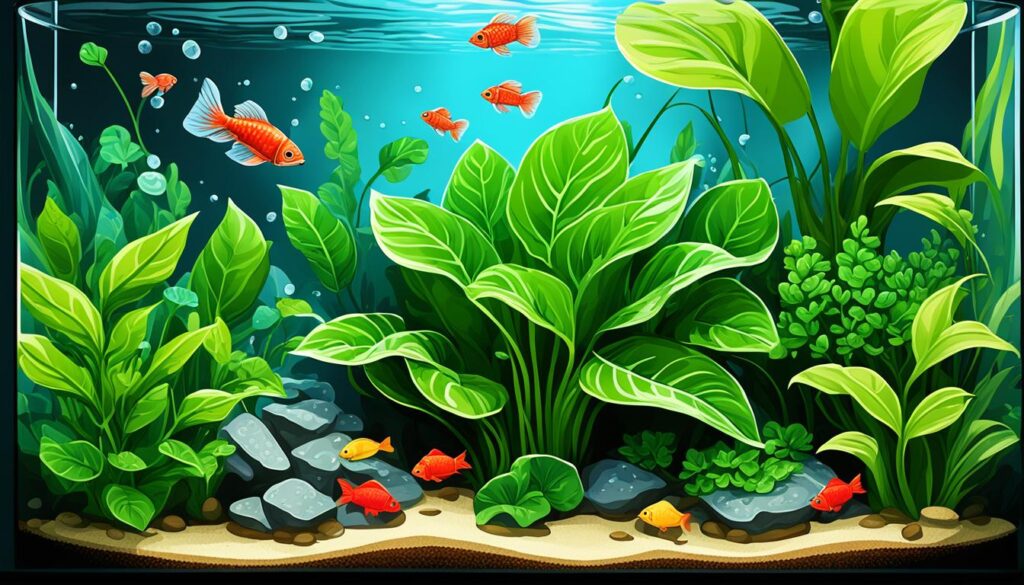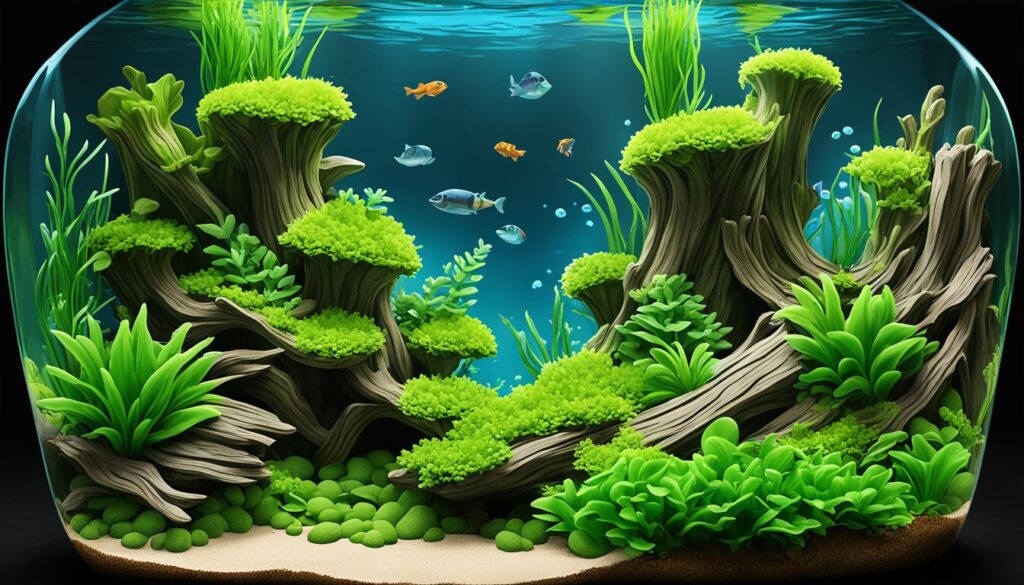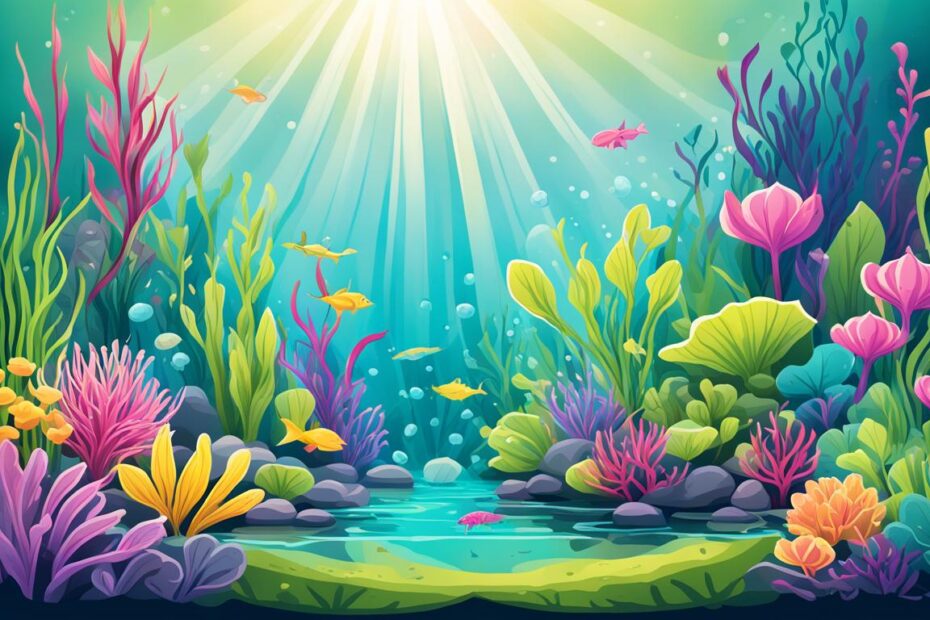Are you tired of dealing with messy substrates in your aquarium? What if we told you there’s a way to have a vibrant aquatic display without the hassle of soil? Yes, you heard it right! There are aquarium plants that can thrive without soil, making them a fantastic option for low-maintenance and visually stunning setups. But how do these plants survive without soil? And which ones are the best for your tank? Let’s dive into the world of soil-free aquarium plants and find out!
- Soil-free aquarium plants can be easily attached to driftwood or rocks.
- These plants absorb nutrients directly from the water, eliminating the need for substrate.
- Java Fern, Anubias, Bucephalandra, Hydrocotyle Tripartita, and mosses are some of the top soil-free aquarium plants.
- Providing adequate nutrients and fertilization promotes the growth of these plants.
- Soil-free plants offer versatility, beauty, and low-maintenance care for your aquarium.
Java Fern – Versatile and Hardy Choice for Root-Free Growth
When it comes to aquarium plants that don’t require soil, Java Fern is a top contender. This versatile plant is beloved by aquarium enthusiasts for its ability to thrive without substrate. It offers a multitude of variations, including the Needle leaf, Philippine, ‘Windelov’, narrow leaf, and ‘Trident’ variants, ensuring there is a Java Fern suitable for every aquascape.
An exceptional characteristic of the Java Fern is its creeping rhizome. This unique feature allows for easy attachment to rocks or driftwood, making it an ideal choice for root-free growth. Whether you want to create a natural-looking underwater forest or add green accents to specific areas of your tank, Java Fern can fulfill your vision.
Another advantage of Java Fern is its tolerance for a wide range of water parameters. It can adapt and thrive in various conditions, making it a hardy choice for beginners and experienced aquarists alike. Plus, Java Fern can withstand shading and crowding, adding flexibility to your aquascaping options.
While Java Fern can grow in low light conditions, providing adequate nutrients and fertilization can promote faster and greener growth. Ensuring your Java Fern receives the necessary nourishment will enhance its overall health and vibrancy, elevating the visual appeal of your aquarium.
“Java Fern is a versatile plant that can transform your aquarium into a beautiful underwater landscape. Its ability to grow without soil and its wide array of variants make it a popular choice among aquascaping enthusiasts.”
Anubias – Hardy Plants for Easy Care and No Substrate Requirement
If you’re looking for aquarium plants that are low-maintenance and don’t require soil, Anubias is the perfect choice. These hardy plants, such as Anubias barteri ‘nana’ and its variants, can be easily attached to driftwood or rocks, eliminating the need for a substrate. Their lush green leaves add a touch of beauty to any aquatic setup.
Anubias are known for their slow growth, but their resilience makes up for it. They can withstand moderate levels of light and are not prone to being eaten by fish. This makes them an ideal choice for aquariums with different lighting conditions and fish species.
While Anubias can thrive without carbon dioxide injection, providing liquid fertilizers can enhance their growth and vibrancy. These root feeders absorb nutrients from the water, allowing them to flourish in a soil-free environment. With their versatile placement options, you can position Anubias in various locations in your tank, creating a visually stunning aquascape.
Taking Care of Anubias:
- Attach the Anubias plants to driftwood or rocks using cotton thread or fishing line.
- Place your Anubias in a spot with moderate lighting. They can tolerate low-light conditions as well.
- To promote optimal growth, consider supplementing with liquid fertilizers designed for aquarium plants.
- Prune any damaged or yellowing leaves to maintain the overall health of the plants.
“With Anubias, you can effortlessly create a stunning underwater oasis without the need for substrate or complicated maintenance.”

Comparison of Anubias Variants:
| Anubias Variant | Size | Growth Rate | Lighting Needs |
|---|---|---|---|
| Anubias barteri ‘nana’ | Small | Slow | Low to Medium |
| Anubias barteri ‘coffeefolia’ | Medium | Moderate | Low to Medium |
| Anubias barteri ‘petite’ | Extra Small | Slow | Low to Medium |
These are just a few examples of popular Anubias variants available in the aquarium trade. Each variant offers its unique characteristics and visual appeal. Consider experimenting with different variants to add variety to your aquascape.
Bucephalandra – Unique and Colorful Soil-Free Plants
Bucephalandra, also known as Buce, is a visually striking plant that can be grown without soil. With a wide variety of leaf shapes and color tones, Bucephalandra adds a unique touch to any aquarium. These plants can be attached to rocks or driftwood and do not require substrate. While they do not need carbon dioxide injection, providing it can result in more vibrant coloration. However, it is important to note that Bucephalandra is generally costlier than other soil-free plants, making it a choice for those willing to invest in their aquascape.
Hydrocotyle Tripartita – Ideal for Ground Cover and Hardscape Attachment
Hydrocotyle tripartita is a versatile plant that adds beauty and functionality to your aquarium. Known for its ability to create lush ground covers and attach to cracks and crevices in hardscapes, this aquatic plant is a popular choice among aquascapers.
Hydrocotyle tripartita propagates through runners, allowing it to spread and fill in empty spaces, creating a visually captivating aquascape. When rooted into nutritious substrate, it grows aggressively, providing a dense and vibrant ground cover.
However, if you prefer to grow Hydrocotyle tripartita on hardscape elements, it offers excellent control through frequent pruning. By trimming the plant regularly, you can maintain its desired shape and prevent it from overwhelming other elements in your aquarium.
This plant thrives well in CO2-injected tanks, as the additional carbon dioxide promotes healthier growth and enhances its attractive appearance. With its unique ability to adapt and fill in empty spaces, Hydrocotyle tripartita is an excellent choice for creating visually stunning aquascapes with a touch of lush greenery.

Benefits of Hydrocotyle Tripartita
Here are some key benefits of incorporating Hydrocotyle tripartita into your aquarium:
- Creates lush and dense ground cover
- Attaches to cracks and crevices in hardscapes
- Spreads through runners, filling in empty spaces
- Provides a visually captivating aquascape
- Thrives in CO2-injected tanks for healthier growth
“Hydrocotyle tripartita adds a vibrant touch to any aquascape, creating a dense green carpet that enhances the beauty of your aquarium.”
How to Care for Hydrocotyle Tripartita
Proper care is essential to ensure the health and vitality of your Hydrocotyle tripartita:
- Provide moderate to high lighting for optimal growth.
- Maintain a stable water temperature between 72°F and 80°F.
- Keep the pH level between 6.0 and 7.5 for ideal conditions.
- Provide CO2 injection for enhanced growth and vibrant appearance.
- Fertilize regularly with a balanced liquid fertilizer to ensure nutrient availability.
- Trim the plant regularly to maintain its desired shape and prevent overgrowth.
Hydrocotyle Tripartita Visual Guide
| Appearance | Lighting Requirements | Water Parameters |
|---|---|---|
| Small, round leaves | Modera te to high lighting | pH 6.0 – 7.5 |
| Creeping runners | Temperature 72°F – 80°F | |
| Densely covers substrate or hardscape surfaces |
Mosses – Easy to Grow and Great for Hardscape Focused Tanks
Mosses are a diverse group of aquarium plants that are incredibly easy to grow. They are often used in hardscape-focused tanks to create a lush and natural appearance. Moss can be easily attached to hardscape elements using super glue, and once attached, they require regular trimming to maintain their shape. There is a wide variety of mosses available, each with its own unique characteristics and growth patterns. By using mosses, aquascapers can create stunning surfaces and provide hiding spots for fish.
| Moss Type | Characteristics | Growth Pattern |
|---|---|---|
| Java Moss (Taxiphyllum barbieri) | Soft and delicate; bright green color | Creeping; forms dense mats |
| Weeping Moss (Vesicularia ferriei) | Graceful, drooping branches; vibrant green color | Upside-down triangle shape; cascading growth |
| Christmas Moss (Vesicularia montagnei) | Branches resemble tiny fir trees; dark green color | Irregular, bushy growth; forms dense clusters |
Conclusion
Transforming your aquarium into a vibrant and low-maintenance display is easier than ever with soil-free aquatic plants. Whether you choose Java Fern, Anubias, Bucephalandra, or mosses, these plants offer both versatility and beauty without the need for substrate. By attaching them to rocks or driftwood, you can create stunning aquascapes and provide natural habitats for your aquatic pets.
With soil-free aquarium plants, you can say goodbye to the hassle of maintaining substrate and hello to a thriving underwater paradise. These plants absorb nutrients directly from the water, resulting in lush green leaves and vibrant growth. They not only enhance the aesthetic appeal of your aquarium but also provide a natural environment that promotes the well-being of your fish and other aquatic creatures.
Explore the world of soil-free aquarium plants and unlock the endless possibilities of aquatic gardening. Create your own unique underwater landscape and enjoy the benefits of a beautiful and thriving aquarium, all without the need for soil. Whether you’re a beginner or an experienced aquarist, these plants are the perfect choice for adding color, texture, and life to your aquatic masterpiece.
FAQ
Are soil-free aquarium plants easy to care for?
Yes, soil-free aquarium plants are generally low-maintenance and easy to care for. They can be attached to rocks or driftwood and absorb nutrients directly from the water, eliminating the need for soil.
Can soil-free aquarium plants be attached to hardscape elements?
Yes, many soil-free aquarium plants, such as Java Fern, Anubias, and mosses, can be easily attached to hardscape elements like rocks and driftwood to create natural and visually appealing aquascapes.
Do soil-free aquarium plants require carbon dioxide injection?
While some soil-free aquarium plants can benefit from carbon dioxide injection, it is not always necessary for their growth. However, providing liquid fertilizers can enhance their growth and vibrancy.
Can soil-free aquarium plants grow in low light conditions?
Yes, some soil-free aquarium plants, like Java Fern and Anubias, can tolerate a moderate level of light and can grow in low light conditions. However, providing adequate nutrients and fertilization can promote faster and greener growth.
Are soil-free aquarium plants safe for fish?
Yes, soil-free aquarium plants are generally safe for fish. In fact, some plants like Anubias are not prone to being eaten by fish. However, it’s always a good idea to research the specific needs and compatibility of your fish species with the chosen plants.
Can soil-free aquarium plants be used as ground cover?
Yes, some soil-free aquarium plants, like Hydrocotyle Tripartita, can be used as ground cover, providing lush green coverage and filling in empty spaces in the tank.
How do I attach soil-free aquarium plants to driftwood or rocks?
Soil-free aquarium plants can be easily attached to driftwood or rocks using nylon thread or fishing line. Simply tie the plant to the desired hardscape element, making sure it is secure and positioned correctly.
Can soil-free aquarium plants be propagated?
Yes, many soil-free aquarium plants can be propagated through division or by separating and replanting new shoots or runners. This allows for the expansion of the plant population in the tank.
Do soil-free aquarium plants provide natural habitats for aquatic pets?
Yes, attaching soil-free aquarium plants to rocks or driftwood can provide natural hiding spots and breeding areas for aquatic pets, creating a more natural and stimulating environment for them.
